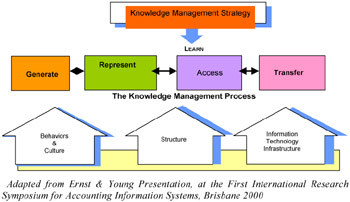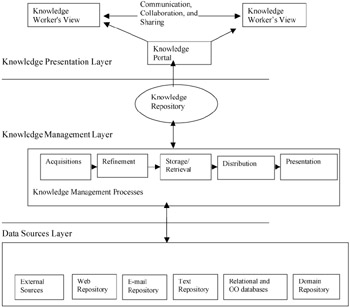Knowledge Management Systems
|
Knowledge management requires several components: access to both internal and external information sources, repositories that contain explicit knowledge, processes to acquire, refine, store, retrieve, disseminate and present knowledge, information technology to provide automation support and people who would facilitate, curate and disseminate knowledge within the organization. Knowledge is of two kinds: tacit and explicit. Tacit Knowledge is personal, context specific, and difficult to formulize and explain. This includes know-how, crafts, and skills or even knowledge created by human beings as mental models such as schemata, paradigms, perspectives, beliefs and viewpoints, etc. Explicit Knowledge on the other hand is codified knowledge and refers to knowledge that is transmittable in formal systematic language such as that contained in documents, reports, memos, messages, presentations, database schemas, blueprints, architectural designs, etc.
Knowledge is not static; instead, it changes and evolves during the life of an organization. What is more, it is possible to change the form of knowledge; i.e., turn existing tacit knowledge into new explicit and existing explicit knowledge into new tacit knowledge or to turn existing explicit knowledge into new explicit knowledge and existing tacit knowledge into new tacit knowledge. These transformations are depicted in Table 1.
| From/To Tacit | Knowledge | Explicit Knowledge |
|---|---|---|
| Tacit Knowledge | Socialization (Sympathized Knowledge) | Externalization (Conceptual Knowledge) |
| Explicit Knowledge | Internalization (Operational Knowledge) | Combination (Systematic Knowledge) |
Given the importance of knowledge, systems are being developed and implemented in organizations that aim to facilitate the sharing and integration of knowledge; i.e., support and facilitate the flow of knowledge. Such systems are called Knowledge Management Systems (KMS) as distinct from Transaction Processing Systems (TPS), Management Information Systems (MIS), Decision Support Systems (DSS) and Executive Information Systems (EIS) (Alavi, 1999). For example Cap Gemini Ernst & Young, KPMG and Acenture all have implemented KMS (Wickramsinghe, 1999). In fact, the large consulting companies were some of the first organizations to realize the benefits of knowledge management and plunge into the knowledge management abyss. These companies treat knowledge management with the same high priority as they do strategy formulation, an illustration of how important knowledge management is viewed in practice (Wickramasinghe, 1999). Essentially, these knowledge management systems use combinations of the following technologies: the Internet, intranets, extranets, browsers, data warehouses, data filters, data mining, client server, multimedia, groupware and software agents to systematically facilitate and enable the capturing, storing, and dissemination of knowledge across the organization (Alavi, 1999; Davenport & Prusak, 1998; Kanter, 1999). Unlike other types of information systems, knowledge management systems can vary dramatically across organizations. This is appropriate if we consider that each organization's intellectual assets, intangibles and knowledge should be to a large extent unique, and thus systems enabling their management should in fact differ.
The KM architecture that could be used for knowledge capture, creation, distribution and sharing is shown in Figures 3 and 4.

Figure 3: Key Elements of a Knowledge-Based Enterprise.

Figure 4: KM Architecture.
|
EAN: 2147483647
Pages: 195